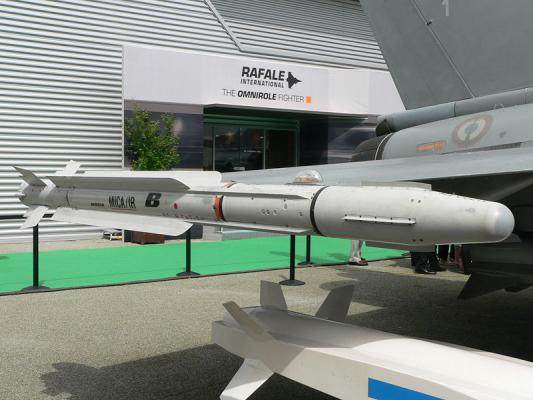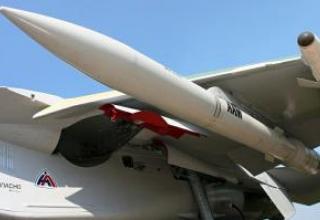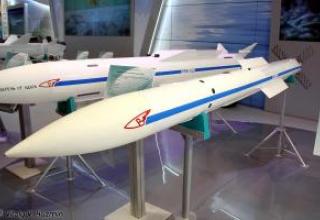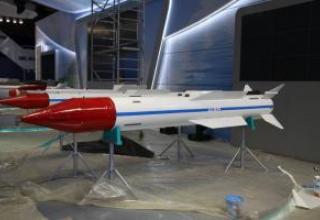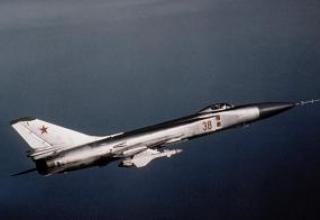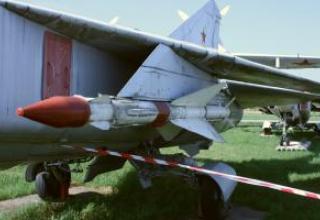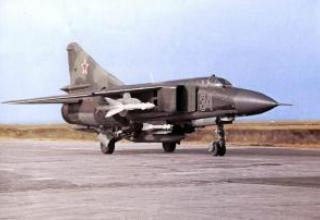MICA "dual-purpose" aircraft missile (short/middle range) is designed to intercept and destroy highly maneuverable manned and unmanned enemy vehicles day and night, from any direction, in the front and rear hemispheres, against the ground and with active radioelectronic counteraction.
The development of the MICA (Missile d' Interception et de Combat Aerien) guided missile (LR) was initiated by Matra in 1982. This weapon system was created as a single replacement for short range "Magic-2" and medium range "Super 530D/F" missiles. Full-scale work on the MICA program in accordance with the assignment of the French Air Force and Navy was launched in 1987.
The missile was designed as a universal platform to accommodate various interchangeable (modular) homing systems. Depending on the version, the MICA can be equipped with either an Active Pulse-Doppler Homing Head (MICA-EM) or a Thermal Imaging Head (MICA-IR). When designing the missile, great attention was paid to increasing the maximum ballistic and guaranteed range. As a short range missile MICA has a relatively low launch weight, high maneuverability, gas-dynamic control system, the possibility of using the launchers of missiles AIM-9. As well as medium-range missiles, this missile has an inertial-corrected guidance system and a long system launch range, which is typical of this type of missiles. Due to the general trend of expanding the combat applications of modern air-to-air missiles, the MICA missile can be conventionally classified as a "dual-purpose" missile - short / medium range.
The MICA flight tests began in 1991. The missile was adopted for service in the MICA-IR version in 1998 and in the MICA-EM version in 1999. The missile is armed with Mirage 2000-5/9, Rafale-M, Mirage-F1, Mirage-III, Mirage-V, Harrier and Jaguar aircraft. It can also be installed on Hawk, F-16 aircraft.
The MICA missile combines the functions of medium-range and close-range weapons, has modifications with different homing heads, implements autonomous modes of application in accordance with the principle of "let's forget", small overall dimensions and weight make the missile very attractive in the arms markets, especially in the Middle East, South and Southeast Asia. The MICA missile could be a real competition for the Russian RVV-AE and the modernized R-73. The issue of interfacing with Russian-made carriers is a technical challenge that can be addressed.
Since 1994, Matra and ONERA have been conducting joint research to develop a direct-flow air jet engine (DIR) for MICA. The use of WFD can provide a significant increase in flight range in the future.
The VL-MICA air defense system has been developed on the basis of the MICA air defense system.
Currently, the MICA is in service with the Air Forces of France, Greece, Qatar, Taiwan, UAE and others.
Composition:
The rocket provides a solution to the following problems:
- intercept;
- engaging in long-range air combat outside the visual range of the target (BVR mode - "Beyond Visual Range");
- conducting close maneuverable air combat;
- missile self-defense of carrier aircraft.
MICA rocket is made according to the normal aerodynamic scheme and is equipped with a cross-shaped wide chord wing of small elongation. Stabilizer planes with rectangular shape are installed in the forward part of the hull. In the middle part of the missile is a Protac RDTT, equipped with a low smoky blended fuel charge. The RDTT provides a maximum flight speed of M=3.5-4. The rear part of the missile contains aerodynamic rudders, an engine thrust vector control system (IUVT) (see photo) and a data line receiver. SHUT is activated immediately after the missile descends from the launch guide and together with the aerodynamic rudders provides maneuvering of the missile with an overload of up to 50g.
The combat unit is a shrapnel-flagged one, the fuse is an active radar.
For suspension of the missile are wing rail launchers that provide launch with an overload up to 9g, or pneumatic catapult, providing launch from the inner compartments of the carrier (up to 4g). MICA electric connectors and suspension units are compatible with AIM-9, "Super 530" and "Magic" missiles.
A combined control system is used to control the missile: a command-inertial system on the initial section of the trajectory and a homing system on the final section. Depending on the version, the missile can be equipped with an active impulse Doppler Cruise Launcher (MICA EM) or a thermal imaging Cruise Launcher (MICA IR). The MICA can be used in the following modes:
- Launching a target outside of visual sight with the homing head picking up the target from the inertial system and receiving correction commands from the carrier aircraft if the target trajectory changes.
- Target launch out of visual sight, with the homing head picking up the target on a trajectory without using a data line. In this mode, the missile is applied according to the "let-forget" principle, the trajectory on the march section is optimized to achieve maximum range.
- Launch with the capture of the CSS target missile on the suspension of the aircraft carrier information from the sighting systems of the carrier, the carrier after launch - an autonomous.
- Launch with the capture of a visually observable target CSS missiles on an aircraft carrier suspension using a helmet-mounted target designation system (NLC).
In the homing area, the MICA EM missile is controlled by the AD4A (12-18 GHz) Active Pulse-Doppler SOS developed by Dassault Electronique and GEC-Marconi. The AD4A is capable of independently capturing the target on the trajectory and ensures the engagement of targets from any direction, at all angles, day and night, in simple and difficult weather conditions, in conditions of intensive radioelectronic counteraction, against the background of the Earth and water surface. The AD4A is placed in the nose section of the missile under a radio-transparent ceramic fairing. The modified version of AD4A is also used as part of the Aster anti-aircraft missile of SAMP-T and PAAMS systems.
Sagem Defense Segurite developed the MICA-IR's 3-5 and 8-12 micrometer band Neutral Thermal Homing Head (THHH). The TGSN contains a sensor matrix installed in the focal plane, an electronic unit for digital signal processing, an integrated cryogenic system for cooling the matrix of closed type. Cooling system of TGSN provides autonomous operation of the receiver within 10 hours. High resolution and complex algorithms allow the TGSN to effectively accompany targets at long distances and to disperse heat traps. TGSN has the ability to capture the target on the trajectory after the launch of the missile, mates with the inertial control system and data line, which allows you to get long range launches and provides the opportunity to use the bearing, superior angles of pumping coordinator. TGSN is built on a digital element base, which allows reprogramming algorithms of work. Pairing with the aircraft according to MIL-STD-1553 standard.
Technical specifications of the TGSN:
- TGS activation time : less than 120s
- pumping angle of the coordinator: ± 60°
- angular velocity of the target sighting line: more than 30 deg/c
- length : 625mm
- diameter : 160mm
- weight : 11kg
- supply voltage : ± 21V
- power consumption : 110W
- operating temperature range: -46° to 71°C
Characteristics:
| Range of fire, km | 0.5-50(60) |
| Length, m | 3.1 |
| Diameter,mm | 160 |
| Wingspan, mm | 560 |
| Weight, kg | 110 |
| Weight BC, kg | 12 |
Testing:
MTUR "Malyutka" was very successfully used during the Arab-Israeli War in 1973, it was with its help that almost the entire Israeli tank fleet was destroyed - about 800 vehicles. Only on October 6, 1973, for example, the 252nd Israeli Tank Division was defeated - more than a hundred vehicles were hit.
Sources:
- Системы управления вооружением истребителей: Основы интеллекта многофункционального самолета /РАРАН; Л.Е.Баханов и др.; под ред. Е.А.Федосова М.:Машиностроение, 2005.400с. (Справ.б-ка разработчика исследователя).
- Легкая управляемая ракета средней дальности MICA
- MICA
- Mica IR

